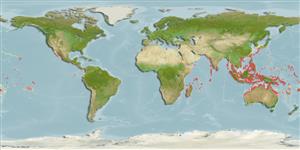Environment: milieu / climate zone / depth range / distribution range
Ecología
marino asociado a arrecife; rango de profundidad 1 - 15 m (Ref. 86942). Tropical
Indo-West Pacific: Sri Lanka to Fiji (Ref. 9710) and Tonga (Ref. 53797), north to Taiwan, south to northern Australia.
Tamaño / Peso / Age
Maturity: Lm ? range ? - ? cm
Max length : 12.0 cm TL macho / no sexado; (Ref. 2272)
Espinas dorsales (total): 9; Radios blandos dorsales (total): 11-12; Espinas anales 3; Radios blandos anales: 11 - 12; Vértebra: 25. Young green when in seagrasses and greenish brown on reefs. Recognized by the unusual color patterns on the cheek or the black spotted scales over the back (Ref. 48636). Preserved male specimens with pale spots on scales; dark spot behind eye (continuous with a bifurcating dark band which extends ventrally); another on opercle; a dark band on snout from upper lip to eye; head with bands; spot on upper caudal base may be present or absent (present in females). Anterior lateral line scales with 1-3 pores (usually 2); 5-6 suborbital pores. Anterior dorsal and anal soft rays longer than posterior rays; pelvic fins of males relatively short, not reaching anus.
Found usually in groups (Ref. 90102) in shallow coastal reefs and seagrass flats (Ref. 9710), also in algae-rocky reef flats and lagoons (Ref. 48636).
Life cycle and mating behavior
Madurez | Reproducción | Puesta | Huevos | Fecundidad | Larva
Randall, J.E., 1980. Two new Indo-Pacific labrid fishes of the genus Halichoeres, with notes on other species of the genus. Pac. Sci. 34(4):415-432. (Ref. 2136)
IUCN Red List Status (Ref. 130435)
Threat to humans
Harmless
Human uses
Pesquerías: escaso valor comercial; Acuario: Comercial
Más información
Nombres comunesSinónimosMetabolismoDespredadoresEcotoxicologíaReproducciónMadurezPuestaAgregación para la puestaFecundidadHuevosEgg development
ReferenciasAcuiculturaPerfil de acuiculturaRazasGenéticaElectrophoresesheritabilidadEnfermedadesProcesamientoNutrientsMass conversion
ColaboradoresImágenesStamps, Coins Misc.SonidosCiguateraVelocidadTipo de nataciónSuperficie branquialOtolitosCerebrosVisión
Herramientas
Special reports
Download XML
Fuentes de Internet
Estimates based on models
Preferred temperature (Ref.
123201): 25.1 - 29.3, mean 28.5 °C (based on 2913 cells).
Phylogenetic diversity index (Ref.
82804): PD
50 = 0.5000 [Uniqueness, from 0.5 = low to 2.0 = high].
Bayesian length-weight: a=0.00813 (0.00473 - 0.01397), b=3.05 (2.90 - 3.20), in cm total length, based on LWR estimates for this species & Genus-body shape (Ref.
93245).
Nivel trófico (Ref.
69278): 3.4 ±0.5 se; based on size and trophs of closest relatives
Resiliencia (Ref.
120179): Alto, población duplicada en un tiempo mínimo inferior a 15 meses (Preliminary K or Fecundity.).
Fishing Vulnerability (Ref.
59153): Low vulnerability (10 of 100).
Nutrients (Ref.
124155): Calcium = 108 [64, 190] mg/100g; Iron = 0.795 [0.451, 1.497] mg/100g; Protein = 18.5 [15.6, 20.7] %; Omega3 = 0.152 [0.094, 0.248] g/100g; Selenium = 19.9 [11.4, 37.2] μg/100g; VitaminA = 153 [47, 567] μg/100g; Zinc = 1.9 [1.3, 3.0] mg/100g (wet weight);
